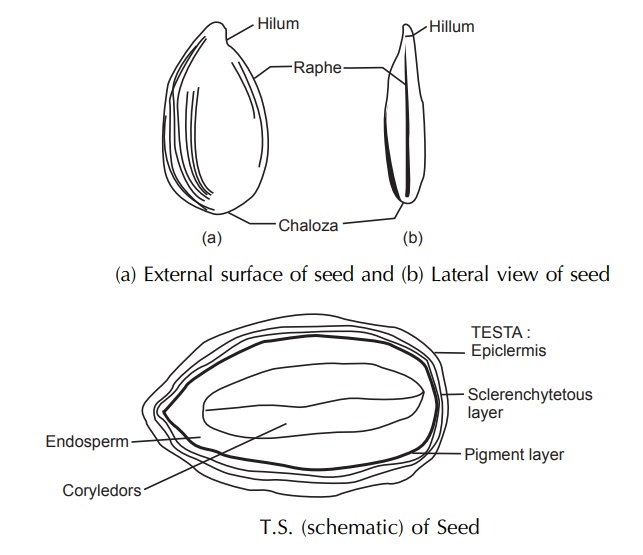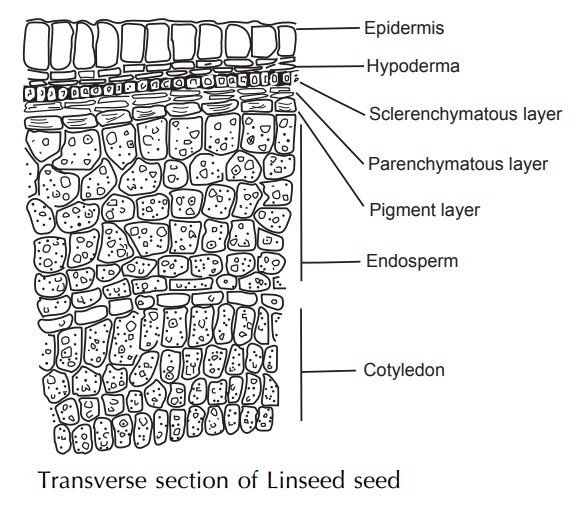Linseed Oil
| Home | | Pharmacognosy |Chapter: Pharmacognosy and Phytochemistry : Drugs Containing Lipids
Linseed is the dried, ripe seed of Linum usitatissimum Linn. Linseed oil is obtained by expression of linseeds, belonging to family Linaceae.
LINSEED OIL
Synonyms
Flax seed, alsi (Hindi).
Biological Source
Linseed is the dried, ripe seed of Linum usitatissimum Linn. Linseed oil is obtained by expression of
linseeds, belonging to family Linaceae.
Geographical Source
Linseed is cultivated in many sub-tropical countries such as
South America, India, United States, Canada, England, Russia, Greece, Italy,
Spain, and Algeria.
Collection
Linseed in an erect annual herb, 60–120 cm high with
sky-blue flowers, and a globular capsule. The plant is cultivated for its seeds
and fibre (flax). A moderate rainfall is best suited for its growth. It grows
in almost all types of soils where sufficient moisture is available, but
thrives best in heavy soils with high moisture retaining capacity. As a mixed
crop it is sown either on the margins of fields or in rows alternating with the
other crop. Nitrogenous fertilizers yield better crop. The crop is harvested in
Feb-ruary and March before the capsules are dried. Plants are cut close to the
ground, dried in the field, and threshed to separate seeds.
Morphology of Seeds
The seeds are oval, flattened, elongated, 4–6 mm long, and
2–3 mm wide. Testa is glossy, smooth, reddish-brown with minutely pitted
surface. Seeds are rounded at one end. The other end is obliquely pointed where
the hilum and micropyle are present in a slight depression. Raphe is present
along one edge. Endosperm is narrow and encircles the embryo. It consists of
two thick flattened, plano-convex cotyledons, and a radicle. The seeds art
odourless but possess an oily and mucilaginous taste.
Microscopical Characters
Under microscope the testa shows a mucilage-containing outer
epidermis; one or two layers of collenchyma or ‘round cells’; a single layer of
sclerenchyma; the hyaline layers or ‘cross-cells’ composed in the ripe seed of
oblit-erated parenchymatous cells; and an innermost layer of pigment ceils. The
outer epidermis is composed of cells, rectangular or five-sided in surface
view, which swell up in water and become mucilaginous. The outer cell walls,
when swollen in water, show an outer solid stratified layer. The radial layers
or ‘round cells’ are cylindrical in shape and show distinct triangular
intercellular air spaces. The sclerenchymatous layer is composed of elongated
cells, up to 250 μm in length, with lignified pitted
walls. The hyaline layers are attached to portions of the sclerenchymatous
layer in the powdered drug. The pigment layer is composed of cells with
thickened pitted walls and containing amorphous reddish-brown contents. The
cells of the endosperm and cotyledons are polygonal with thickened walls, and
contain numerous aleurone grains and globules of fixed oil.

Preparation
The dried seeds are crushed in rollers, moistened and heated
to 80–90°C in steam to soften the seed tissues. They are then pressed through
hot hydraulic press at a high pressure. The oil so obtained is treated with
alkali to separate free fatty acids and bleached with fuller’s earth or
charcoal. On cooling the oil waxy substances are removed.
Linseed oil is a yellowish liquid, with a peculiar odour and
bland taste. On exposure to air it gradually thickens, becomes darker and
acquires a more pronounced odour and taste. On drying it forms a hard varnish.
It has a high iodine value (~170) which indicates the presence of excess amount
of glycerides of unsaturated fatty acids. The oil is slightly soluble in
alcohol, miscible with chloroform, ether, petroleum ether, carbon disulphide,
and terpentine oil. It has density 0.925–0.935, viscosity 1.47, congealing
point ~20°C, saponification number 187–195, refractive index 1.47–1.48, and
unsaponifiable matters not over 1.5%. A water-soluble resinous matter with
antioxidant properties has been isolated from the oil.

Chemical Constituents
Linseed contains fixed oil (30–40%), mucilage (6–10%),
protein (25%) (linin and colinin), small amount of enzyme lipase, and linamarin
which is a cyanogenetic glycoside. The carbohydrates present are sucrose,
raffinose, cellulose, and mucilage. Linamarin is a glucose either of acetone
cyanohydrin and is identical to phaseolunatin. Unripe seeds contain starch
which is converted to mucilage on ripening the seeds. The mucilage can be
fractionated into a neutral fraction a remified, arabinoxylan composed of
D-xylose, -arabinose, -glucose and -galactose; and an acidic frac tion mainly
composed of L-rhamnose and D-galactose. Mucilage swells with water and forms
red colour with ruthenium red. Linamarin on hydrolysis yields acetone,
hydrocyanic acid, and glucose. The other constituents are phytin, lecithin,
wax, resin, pigments, malic acid, cyanogenic glycosides linustatin
neolinustatin, and secoisolariciresinol and phenylpropanoid glucoside
linusitamarin.
On hydrolysis Linseed oil produces unsaturated acids like
linolenic acid (30–50%), linoleic acid (23–24%), oleic acid (10–18%) together
with saturated acids-myristic, stearic, and palmitic (5–11%).
Uses
Linseed is used as demulcent and in form of poultices for
gouty and rheumatic swellings. Internally it is used for gonorrhoea and
irritation of the genito-urinary system. Linseed oil has emollient,
expectorant, diuretic, demulcent, and laxative properties and is utilized
externally in lotions and liniments. Nonstaining iodine ointment soap,
linoleum, greases, polishes, polymers, varnishes, paints, putty, oil cloths,
printing inks, artificial rubber, tracing cloth, tanning and enamelling
leather, etc. are also prepared from Linseed oil.
The mucilaginous infusion is used internally as a demulcent
in colds, coughs, bronchial affections, inflammation of the urinary tract,
gonorrhoea, and diarrhoea.
Adulterants
When market price is high, Linseed oil is adulterated with
vegetable oils, such as rape, cottonseed, soyabean, sunflower, safflower and
candlenut, as well as with rosin and mineral and fish oils. Boiled Linseed oil
is more frequently adulterated than raw oil.
Admixture of rape and mustard oils may be detected by the
presence of erucic acid; the adulterants lower the saponification value. Fish
oil may be detected by the odour produced on heating and by melting points of ether
insoluble bromides. Rosin and mineral oils increase the proportion of
unsaponifiable matter.
Marketed Products
It is one of the ingredients of the preparations known as Canisep and
Scavon (Himalaya Drug Company).
